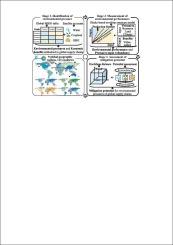全球供应链中的环境压力、绩效和缓解潜力:水、土地和气候的综合视角
IF 9.6
1区 环境科学与生态学
Q1 ENVIRONMENTAL STUDIES
引用次数: 0
摘要
全球供应链的持续扩张在推动经济增长的同时,也在各个方面施加了环境压力。然而,目前仍然缺乏明确的方法来评估减轻供应链中所体现的这些环境压力的潜力。本文采用适应性发展的投入产出分析模型和数据包络分析模型,从水资源、土地和气候三个维度出发,确定了全球供应链中113个国家和9个地理区域的环境压力和环境绩效。进一步制定了缓解潜力的评估方法,以定量地揭示缓解全球供应链内环境压力潜力的强度、方向、结构和地理分布。研究结果表明,低收入国家往往是虚拟水资源和土地资源以及温室气体的净流出国。出口导向型农产品的生产投入造成了86.4%的水压力和90.3%的耕地压力,而服务和能源部门是全球供应链中气候压力的重要来源。NOR、SWE、CHE、GBR、JPN和KOR处于全球供应链环境绩效的前沿,以最低的当地环境压力投入成本实现最高的经济效益。区域间不平衡和密度变化解释了90%以上的环境绩效空间不平衡。到2021年,缓解环境压力的平均潜力为54.9%。低收入国家在全球供应链中的当地蓝水消耗、耕地占用和温室气体排放方面表现出显著的投入冗余。要对这种潜力作出有效反应,就必须平衡国内技术进步和国际贸易管制,以形成全球可持续的生产和消费格局。本文章由计算机程序翻译,如有差异,请以英文原文为准。

Environmental pressure, performance and mitigation potential in global supply chains: An integrated perspective on water, land, and climate
The continuous expansion of global supply chains has been widely recognized for driving economic growth, while simultaneously exerting environmental pressures across various dimensions. However, clear methods for assessing the potential to mitigate these environmental pressures embodied in supply chains remain lacking. Here, by employing input-output analysis model and data envelopment analysis model for adaptive development, we identify the environmental pressures and environmental performance of 113 countries and 9 geographical regions within global supply chains, considering three dimensions: water resource, land, and climate. An assessment method for the mitigation potential is further developed to quantitatively reveal the intensity, direction, structure, and geographical distribution of the potential to mitigate environmental pressures within global supply chains. Results indicate that low-income countries are often net outflows of virtual water and land resources and GHGs. The production inputs for export-oriented agricultural products contribute to 86.4 % of water pressure and 90.3 % of cropland pressure, while the service and energy sectors are significant sources of climate pressure in global supply chains. NOR, SWE, CHE, GBR, JPN, and KOR are positioned at the frontier of global supply chain environmental performance, achieving the highest economic benefits with the lowest local environmental pressure input costs. The inter-regional disequilibrium and trans variation density explain over 90 % of the spatial disequilibrium in environmental performance. The average potential to mitigate environmental pressures in 2021 was 54.9 %. Low-income countries exhibit significant input redundancy in local blue water consumption, cropland occupation, and GHG emissions within global supply chains. An effective response to this potential necessitates balancing domestic technological progress with international trade regulation to form global sustainable production and consumption patterns.
求助全文
通过发布文献求助,成功后即可免费获取论文全文。
去求助
来源期刊

Sustainable Production and Consumption
Environmental Science-Environmental Engineering
CiteScore
17.40
自引率
7.40%
发文量
389
审稿时长
13 days
期刊介绍:
Sustainable production and consumption refers to the production and utilization of goods and services in a way that benefits society, is economically viable, and has minimal environmental impact throughout its entire lifespan. Our journal is dedicated to publishing top-notch interdisciplinary research and practical studies in this emerging field. We take a distinctive approach by examining the interplay between technology, consumption patterns, and policy to identify sustainable solutions for both production and consumption systems.
 求助内容:
求助内容: 应助结果提醒方式:
应助结果提醒方式:


